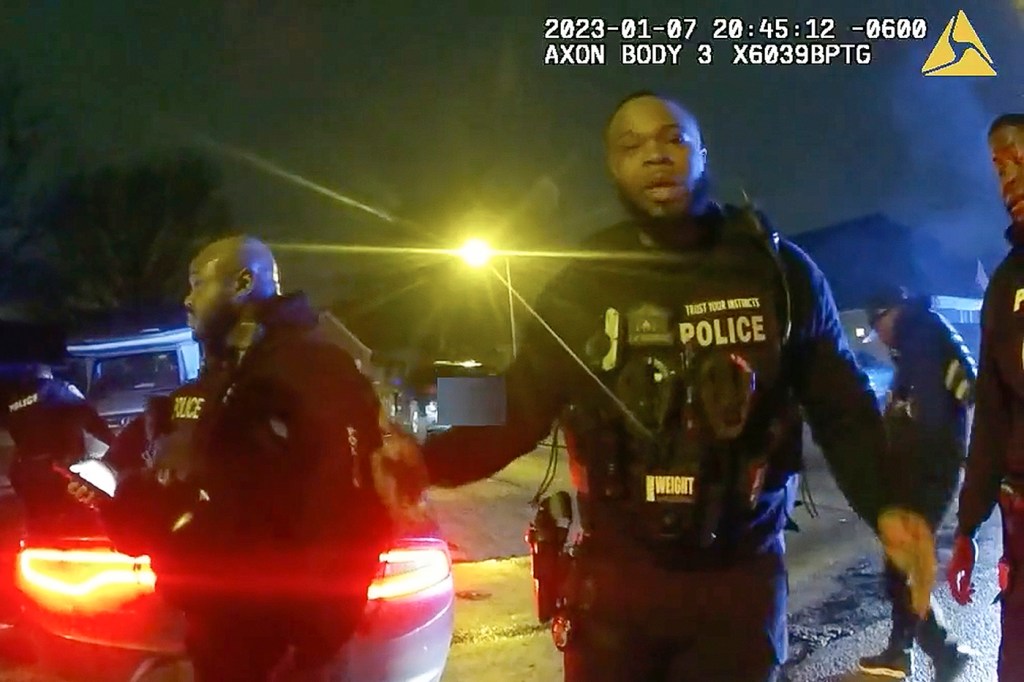The only color that matters is blue. In Tyre Nichols case, police culture trumps race, Northeastern experts say

Bodycam footage of Tyre Nichols’ death at the hands of five Memphis police officers was released on Friday, reigniting the conversation around police violence.
The details of Nichols’ death are all too familiar. On Jan. 7, Nichols, a 29-year-old Black man was pulled over by Memphis police officers. After Nichols attempted to run away, the five officers tasered, pepper-sprayed, kicked, punched and battered Nichols with a baton. At one point, Nichols yelled, “Mom.”
But one detail of Nichols’ death is different: All five of the officers involved are Black.
More often than not the story of police violence in the U.S. has involved white officers committing acts of violence against Black people. The five officers in this case, who have since been arrested and charged with Nichols’ murder, show a different side of the story.
Memphis is a majority Black city, with a Black chief of police, Cerelyn Davis, and majority Black police force: 58% of the department is Black, according to the city of Memphis. The fact that these forms of police violence are still being enacted on Black men in a city like Memphis is indicative of how deeply rooted the problems in police culture are, says Ermus St. Louis, an assistant professor of criminology and criminal justice at Northeastern University.
“Black officers are socialized into the police culture, and that hinders the expected behaviors that we hope to see from Black officers,” St. Louis says. “Police culture eats whatever you throw into it.”
Michael Davis, Northeasterns’ vice president of campus safety and chief of police, has spent a lot of time in and around police departments. After working for more than two decades as a police officer and police chief, he served as a police consultant for the U.S. Department of Justice reviews of fatal police shootings in Ferguson and Cleveland.
Davis called the behavior of the five officers “an affront to humanity” and proof that “simply diversifying a police department is not a panacea to a fundamental misrepresentation of policing as expressed here.”
“This is a moral, ideological, value problem,” he says.
The ingrained behaviors and attitudes in police culture stem, in part, from “a kind of subtle coercion to get conformity,” says Jack Greene, professor emeritus of criminology and criminal justice at Northeastern.
“The simple idea is that when you’re a police officer, somewhere along the line you begin to understand that you depend on your fellow police officers should you get in some trouble,” Greene says. “That then begins to create this internal dynamic of mutual interdependence and perception of a hostile world.”
This dynamic can be particularly complicated and problematic for Black officers who have to wrestle with “dual identities,” St. Louis says: Are they Black or blue?
“They have to show they are with the police and not with the public to some degree,” St. Louis says.
“They are socialized into these ideas that the Black body is more threatening or that it’s more criminal or that they are less deserving of constitutional policing,” he adds.
The us versus them mindset embedded in parts of police culture is especially pervasive in the kinds of specialized units that the officers involved in Nichols’ death served in. Known as SCORPION, or Street Crimes Operation to Restore Peace in Our Neighborhoods, the unit was established in 2021 to respond to violent crime. SCORPION was officially shut down on Saturday in light of the murder charges brought against the five officers.
Greene was not surprised to learn that at least some of the officers served in a special unit like SCORPION. He says the violent tactics on display in the bodycam footage are indicative of how these units typically operate, another systemic issue that needs to be addressed.
“When you create a street crime unit, their only focus is on what they perceive to be street crime, real or imagined––and that’s really a concern,” Greene says. “If you only have a hammer, everything looks a nail. … If they’re not really reined in considerably, they can become rogue elements within police agencies. That then affords the kind of misbehavior and the violence that you saw in that clip from Memphis.”
If police departments have units that are rewarded for “aggressively getting people off the street,” it doesn’t matter what race those officers are, Greene says; the outcome will be the same.
So, what is the solution?
According to Davis, the problem is more than just the race of the person wearing the badge. It’s a multidimensional problem that requires a multidimensional answer. That requires taking a close look at the culture and mission from the broad department level all the way down to the officer on the street. It requires asking a lot of questions about a department’s objective, what it rewards and what it penalizes officers for and how it measures outcomes that match with the expectations set by the community.

“The hope is that organizations … look at this in advance with the necessary level of complexity beyond just the fact that ‘We have a diverse police department,’” Davis says. “What is the culture of the organization, and what are the expectations?”
But St. Louis says the issues in police culture are too entangled with broader American structures to fix with just department reforms.
“Policing in America is a reflection of the people in America,” he says. “What police do is a reflection of what we allow them to do to some degree, so if we’re going to change policing, we need some structural changes in America more broadly.”
Cody Mello-Klein is a Northeastern Global News reporter. Email him at c.mello-klein@northeastern.edu. Follow him on Twitter @Proelectioneer.






